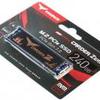Specifications & Features
Specifications & Features
Team Group has released theCardea Zero M.2 SSDs with two products, available in 240 GB and 480 GB capacities. With NVMe 1.2 support, Cardea series significantly reduces access latency to provide faster data transmission speeds. Combined with the PCIe Gen 3 x4 interface, the M2 unit can provide breakthrough performances. The Cardea SSDs boast sequential read speeds up to 2,600 MB/s regardless of capacity, and sequential writes of up to 1,400 MB/s. When it comes to random I/O, they can do do 180K read IOPS. Random write figures are 140K IOPS for the 240 GB and 150K IOPS for the 480 GB drive.
The Cardea M.2 NVMe storage devices come with a new copper plated thermal adhesive sticker. The Phison controllers can get warm, hence they developed it this way to keep controller temperatures under control and thus performance under heavy writes fast. The sample that have arrived in our test lab is the 240 GB M.2 version of the drive with that heatsink slash cover. The series will come with MLC NAND flash memory from the 15 nm Toshiba NAND node. Given its size, this has to be vertical stacked nand or V-nand, that information however is not disclosed.
So What Is V-NAND?
V-NAND is physical vertical NAND cell stacking not to be confused with chip stacking in a multi-chip package. In V-NAND, NAND layers, not chips, are stacked in a single IC. The good news is continued cost reduction, smaller die sizes and more capacity per NAND chip. Also, installed NAND toolsets in the wafer fabs can, for the most part, be reused, thereby extending the useful life of fab equipment. Current V-NAND stacks have 32 and even 48 cell layers vertically over one another, rather than decreasing cell dimensions to fit onto a fixed horizontal space, resulting in higher density and better performance with a smaller footprint. 64 layer (BICS) actually is going into production this year as well. With the M.2 form factor SSDs, more consumers with desktops or ultra-thin PCs can benefit from best-in-class performance and reliability of the technology.
So What Is NVMe?
NVMe is also known as Non-Volatile Memory Express or the Non-Volatile Memory Host Controller Interface Specification. The idea behind NVMe is to improve the storage stack by optimizing the way an application accesses a Flash device. NVMe cuts corners by removing components within the I/O path like that good old fashioned RAID controller. To be able to make use of the new NVMe based devices inside your PC you have to have a proper driver installed, Windows 7, 8 and 10 have this NVMe protocol driver embedded. This enables NVMe
Specifications:
- NVMe PCI Express Gen. 3 x4 interface provides up to a 5x performance improvement over SATA SSDs, allowing you to access all your data with blazing speed.
- M.2 2280 industry standard compact form factor.
- Available in various storage capacities including 240 GB and 480 GB.
- Compatible with Microsoft Windows, Mac OS X, and Linux, with no special driver or administrative rights required.
- Enhanced error correction improves data retention.
- Toughened contact surface material gives better contact to the motherboard and provides vibration resistance.
- Static and dynamic wear-leveling extends the life of the disk SSD.
- Advanced garbage collection support provides extended drive management tasks.
- 3-year warranty.

Look and find... dimensions 80.0(L) x 22.0(W) x 3.3(H) mm / 8 gram

